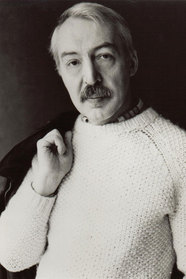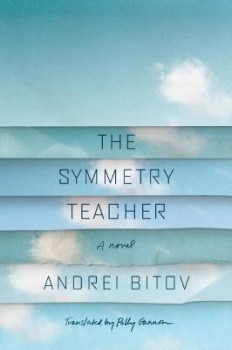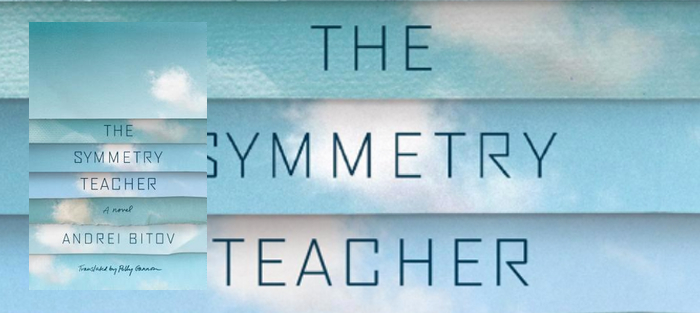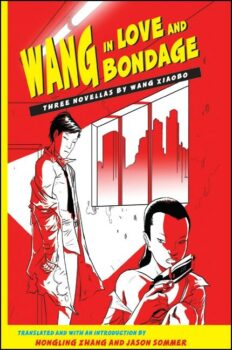In the original Russian publication of Andrei Bitov’s The Symmetry Teacher, which was released by Moscow publisher Fortuna El in 2008 with the title Преподаватель симметрии (Prepodavatel’ simmetrii), the author begins with a “Foreword of the Translator,” which he published in a Russian journal in 1971 and in which he claims not to be the novel’s author but its translator.

Andrei Bitov photo credit Jerry Bauer
This “Foreword of the Translator” is rendered as “A Note from Andrei Bitov” by Polly Gannon, the translator of the U.S. version, published by Farrar, Straus, and Giroux earlier this summer. In his “note,” Bitov explains that the book he has written in Russian is not his, because it is an “echo” of an English novel, The Teacher of Symmetry, by A. Tired-Boffin. By “echo,” Bitov means that he has remembered and translated into Russian from memory alone Tired-Boffin’s originally English novel, which Bitov read one summer in his youth. Both the Russian publication and this latest U.S. translation have a separate English title page for The Teacher of Symmetry, with a menacing portrait of the supposed A. Tired-Boffin.
If we’re to believe Bitov, his Russian echo-translation of the British novel The Teacher of Symmetry has now been translated back into English by Polly Gannon as The Symmetry Teacher. This English translation of Bitov’s Russian publication seemed inevitable. The Russian publication itself contains plenty of English, and translation already makes up a large part of the novel’s content, even style, with poems written in English as well as a Russian-accented phonemic letter in something resembling a pidgin of the two languages, which appears in the 3rd chapter, “The End of the Sentence (The Talking Ear).”
In this chapter the protagonist of Tired-Boffin’s novel, a Brit with Polish ancestry named Urbino Vanoski, announces that, like Russian works of literature, his does not have a plot—Gannon’s translation of the word сюжет (syuzhet) from the Russian publication. The similarity of this Russian word to the English word subject is enough to make Gannon use subject instead of plot when translating сюжет later in the chapter: “No, Russians can’t have a subject! They can only have a fate.” Of course, this is understandable in translation: depending on the context, one word can have more than one equivalent.
Instead of discovering a plot, or a subject, Vanoski describes a character, his drinking buddy, a Russian named Anton. With Vanoski he speaks English learned on expedition alongside the late British explorer Robert Scott, whom the two characters are memorializing in a pub. Actually, Tired-Boffin points out in a footnote that Anton mistakenly uses the word memorizing. Of course, writing his meticulous echo-translation, Bitov would have had to remember this footnote, because it appears in the Russian publication, as well. But there, since Anton is Russian, the word помянуть (pomyanut’)—a different spelling of the Russian word поминать (pominat’), to mention or to speak kindly of—is used, which actually does mean to memorialize. To memorize would use the same root, but would be запоминать (zapominat’). So, in the Russian, the footnote is there, but nonetheless gives the correct Russian word, which Anton would have used correctly, as if his mistake could only occur in English and not in Russian.
Here the savvy reader, aware that this is a translation, must stop, unfamiliar with a translation back into the original language of what is supposed to be another translation. Again, if we’re to believe Bitov, he translated Tired-Boffin’s footnote into Russian, but corrected Anton’s mistake in English, since Anton wouldn’t make such a mistake in Russian. By translating Bitov’s Russian text, has Gannon mysteriously rediscovered Tired-Boffin’s depiction of Anton’s mistake? And how can we be sure this was truly the mistake, or that there was a mistake at all, now that we’ve passed from one language through another and returned to the original? The pleasure of reading The Symmetry Teacher in part consists of the Mobius strip of reflection the two versions make of one another. Questions such as those above suggest the mystery evoked by a further translation of a supposedly already translated novel. That only an English-language translation of the Russian version can bring up such questions deepens this unique pleasure.
With a strange mixture of mysticism and scientific reason, a very Russian trait, Anton has fun comparing and contrasting the two languages. Perhaps this character resembles Bitov, who suspected Vanoski of resembling Tired-Boffin:
Anton had many favorite little words and expressions, some of them even English. Not only was there “knowmen,” but also “knowhow.” “Neekhuyaneeknowhow-knowhowneekhuya,” he intoned sadly, and this rang very pleasantly in my ear.
It may ring pleasantly to Vanoski, but the Russian joke’s on him. It has to do with the phonemically spelled Russian word neekhuya. Even in the Russian text, khuy, the curse word at the root of this conglomeration, is in Roman letters, softening the sight of it for Russian-language readers. The effect could be the same as when an English speaker attempts to curse in Russian. Often this is more amusing to Russian native speakers than they themselves cursing.
So, then, for whom was this book intended? Is a reader of the U.S. translation supposed to laugh at the joke on Vanoski, unknowingly pronouncing this high-ranking Russian curse word? After the neekhuya exchange, the U.S. translationhas six lines that do not appear in the Russian publication. They start with Vanoski’s question:
“Neekhuyanee…means ‘nothingdoingness’?”
“More like ‘doingnothingness.'”
“A subtle difference! So, which one is more correct?”
“Both are worse than neekhuja!” (You can imagine my surprise when I learned some years later that his expression meant, more literally, “Nofrigginknowhow-nohowfrigginway.”)
This barroom banter about neekhuya depicts Vanoski’s tardy realization of the word’s meaning, nofriggin—frig, of course, being a common euphemism for the more serious English equivalent, fuck. It’s as if readers of the U.S. translation can’t handle the F-bomb, just like Russian readers supposedly couldn’t handle the Х-bomb—х being the Cyrillic letter kh. And Vanoski’s realization—like that of most readers of the U.S. translation, the only place where these lines appear—would not have been necessary for Russian-language readers to be in on the joke. So, is this why it’s absent in the Russian publication? In this case, Gannon’s text is taking the idea of translation beyond the simple word-by-word transfer of the novel from one language into the other. It translates the experience of the novel in a way that matches the experience of the English-language reader.
These added lines bring up other questions faced by translators. They feature either a typo or an intentional spelling difference between two instances of neekhuya—neekhuja further down. Mistaking the German j for the English y happens frequently in transliteration of Cyrillic and Russian. So, who wrote this extension, Gannon or Bitov? And in which language, Russian or English, was it originally written?
During another conversation, Gannon has completely changed the lines of the Russian publication to avoid using a word very derogatory in English and less so in Russian. While discussing Britain’s colonial history, Vanoski asks, “Ю мин blacks?” (in Cyrillic, the two initial sounds are yu min, pronounced you mean). This resembles non-English conversations, in which the speakers throw in English phrases here and there for emphasis before slipping back into their native tongue. Since Vanoski is British, it makes sense that he would use the term “blacks,” much less offensive than the common Russian word негр (negr), the term Anton uses in the Russian publication.
However, in the U.S. translation, the whole conversation has changed. Whereas, in the Russian publication, Anton uses the term along the black or on the black, a phrase meaning in a bad way, in Gannon’s translation he says: “You’re stealing [the world] black, blue, and blind!” In place of Vanoski’s half-Cyrillic question in the Russian original, Yu min “blacks,” the U.S. translation has, “Are you referring to the slave trade?” Also, in Gannon’s translation, Anton does not use the Russian term негр, the sound of which is so viscerally charged in English, but has Anton go on without referring to “blacks” at all, even in the more innocuous way Vanoski did. It’s as if Gannon were not just translator but co-writer of this bilingual work of literature, which a reader might consider not merely made up of these two languages, in a sense, but as itself one piece made up of both separate publications, with many parts overlapping.
An example of such overlapping is the earlier mentioned letter, written by Anton to Vanoski, which is much the same in the Russian publication:
Deap fpehd! Raitin English fyurst taim in mai laif! I rite uyo in zaimke, haunting uan Amerikan. Zei a not rial soldgeps! Bat weri well ekvipt! We a hauntin zem laik kuropatok—smol Rashn vaild hens—uan prope shot end sri aurs ken bi dresst. Its raze kold tu veit—I dreem abaut a guud shot of Whiskey—luuk! I remember hau it voz rittn on ze botel!—viz uyo, mai Dalink! Bat tuu fa iz yoz Anton! Drug (vor-frend) creep op tikhoi sapoi viz samogon (aue Whicky)…
This does not sound like the Anton who was so eloquent in the pub. A reader must remember that the earlier English conversation, unlike the text above, comes from Vanoski’s memory of an evening at the pub, written by Tired-Boffin, which has been read, remembered, and translated into Russian by Bitov, and finally translated back into English by Gannon. The silliness of this volley between the languages itself is not just amusing, it makes a reader laugh out loud.
The only difference between the Russian publication’s letter and the U.S. publication’s is in some Cyrillic letters Gannon has transliterated into Roman ones. In fact, that’s a main part of the joke: the greeting alone toys with and subverts the two alphabets of English and Russian. The first word, “deap,” uses the Cyrillic letter р, which as any reader of English can see looks like the Roman letter p but makes the sound r. It comes up again in the second word, fpehd, with a p for an r, and an h for an n—in Cyrillic the letter н. In short: “Dear Friend.” And this is only the first two words.
Of course, like any joke’s straight man, Vanoski doesn’t get the bilingual humor of the letter. Potentially annoyed English-language readers should consider what it was like for a reader of Russian alone, seeing this section on a page otherwise filled with Cyrillic’s steel beams and false cognate letters.
 While thinking of Russian readers of this book, it’s interesting to consider the greatest influence on The Symmetry Teacher: Laurence Sterne’s Tristram Shandy, a novel which for more than two centuries has entertained countless readers and annoyed some as well. The 6th chapter of The Symmetry Teacher has the title “Posthumous Notes of the Tristram Club (The Inevitability of the Unwritten)” and makes this influence explicit. The Tristram Club is made up of writers of unwritten novels, and one of the club’s rules is that if any member actually publishes his novel, his membership is immediately withdrawn. Instead of writing, they tell one another their ideas, dismissing any novels having to do with famous people, such as Sterne himself, when Vanoski suggests Tristram as the name for the club. Vanoski’s argument goes: “How can Sterne be considered great if everyone has forgotten about him? He is better known in some backwater called Russia than he is in his native England.” The joke’s humor stems from its truth. Russian literati love Sterne, possibly more than those of his native language.
While thinking of Russian readers of this book, it’s interesting to consider the greatest influence on The Symmetry Teacher: Laurence Sterne’s Tristram Shandy, a novel which for more than two centuries has entertained countless readers and annoyed some as well. The 6th chapter of The Symmetry Teacher has the title “Posthumous Notes of the Tristram Club (The Inevitability of the Unwritten)” and makes this influence explicit. The Tristram Club is made up of writers of unwritten novels, and one of the club’s rules is that if any member actually publishes his novel, his membership is immediately withdrawn. Instead of writing, they tell one another their ideas, dismissing any novels having to do with famous people, such as Sterne himself, when Vanoski suggests Tristram as the name for the club. Vanoski’s argument goes: “How can Sterne be considered great if everyone has forgotten about him? He is better known in some backwater called Russia than he is in his native England.” The joke’s humor stems from its truth. Russian literati love Sterne, possibly more than those of his native language.
This has a lot to do with the Russian Formalist Viktor Shklovsky’s 1921 essay “The Novel as Parody: Sterne’s Tristram Shandy,” which draws a comparison between Sterne’s novel in relation to conventional novels and Russian Futurist poetry in relation to conventional poetry. Shklovsky writes that Sterne impedes the action of the novel in order to parody the idea of plot as a simple sequence of events. This method has to do with the idea of defamiliarization—“estrangement” or “enstrangement” are other translations of the Russian word остранение (ostranenie). This idea is defined by Shklovsky in his essay “Art as Device,” also translated as “Art as Technique,” of the same volume as the essay on Sterne:
The purpose of art, then, is to lead us to a knowledge of a thing through the organ of sight instead of recognition. By “enstranging” objects and complicating form, the device of art makes perception long and “laborious.” The perceptual process in art has a purpose all its own and ought to be extended to the fullest. Art is a means of experiencing the process of creativity. The artifact itself is quite unimportant.
Tristram Shandy defamiliarizes the reader with the idea of plot. Over two hundred years later, however, this technique is no longer original. The concept of defamiliarization is familiar to many writers. How, then, does The Symmetry Teacher make defamiliarization radical and innovative again?
The Symmetry Teacher and its Russian version have a different relationship than the traditional one of a translation to an original. The additions and augmentations alone suggest this. The Symmetry Teacher is a bilingual or interlingual novel. Perhaps translingual is the term for it, since the novel refers back to its previous versions. If Tristram Shandy defamiliarizes a reader with the traditional concept of plot, The Symmetry Teacher does the same with the traditional concept of translation and multilingual works of literature. Since the novel purports to have been written as an echo-translation—a translation from memory alone—and the U.S. translation goes beyond the traditional method, then the idea of translation itself becomes disrupted. This disruption is, according to Shklovsky, the purpose of art. Otherwise, why not just plug the original into an Internet translator and arrange the machine’s translation into legible enough prose? Such mechanized translation denatures the mystery from the work of art. As a holy fool character in The Symmetry Teacher puts it, when referring to technology that he himself doesn’t understand, it’s “not a mystery. It’s a secret. Because someone knows. A mystery is something no one knows.”
Mystery is nonetheless necessary to a work of literature. The final add-on to the U.S. translation of The Symmetry Teacher is called “The Flight of the Bumblebee,” an entire two-page chapter which does not appear in the Russian publication. It’s a basic metaphor with an easily translatable meaning: a bee tries to escape the writer’s room to freedom. A reader wonders whether it was composed by Bitov in Russian or English, written by Bitov and translated by Gannon, or perhaps simply added by Gannon herself. Writers two hundred years ago as well as today ask themselves questions about the mystery of a novel’s origin. A writer sits down in a room at a machine or with an apparatus of some kind, something that can do everything except capture that necessary mystery. It is the writer’s—and in this case the “translator’s”—job to turn memories and imaginings into prose.
<Hr/ >
- Bitov, Andrei. The Symmetry Teacher. Trans. by Polly Gannon. New York: Farrar, Straus and Giroux, 2014.
- ___________. Преподаватель симметрии. Moscow: Fortuna El, 2008.
- Shklovsky, Viktor. Theory of Prose. Trans. by Benjamin Sher. Champaign, IL: Dalkey Archive Press, 2009.







